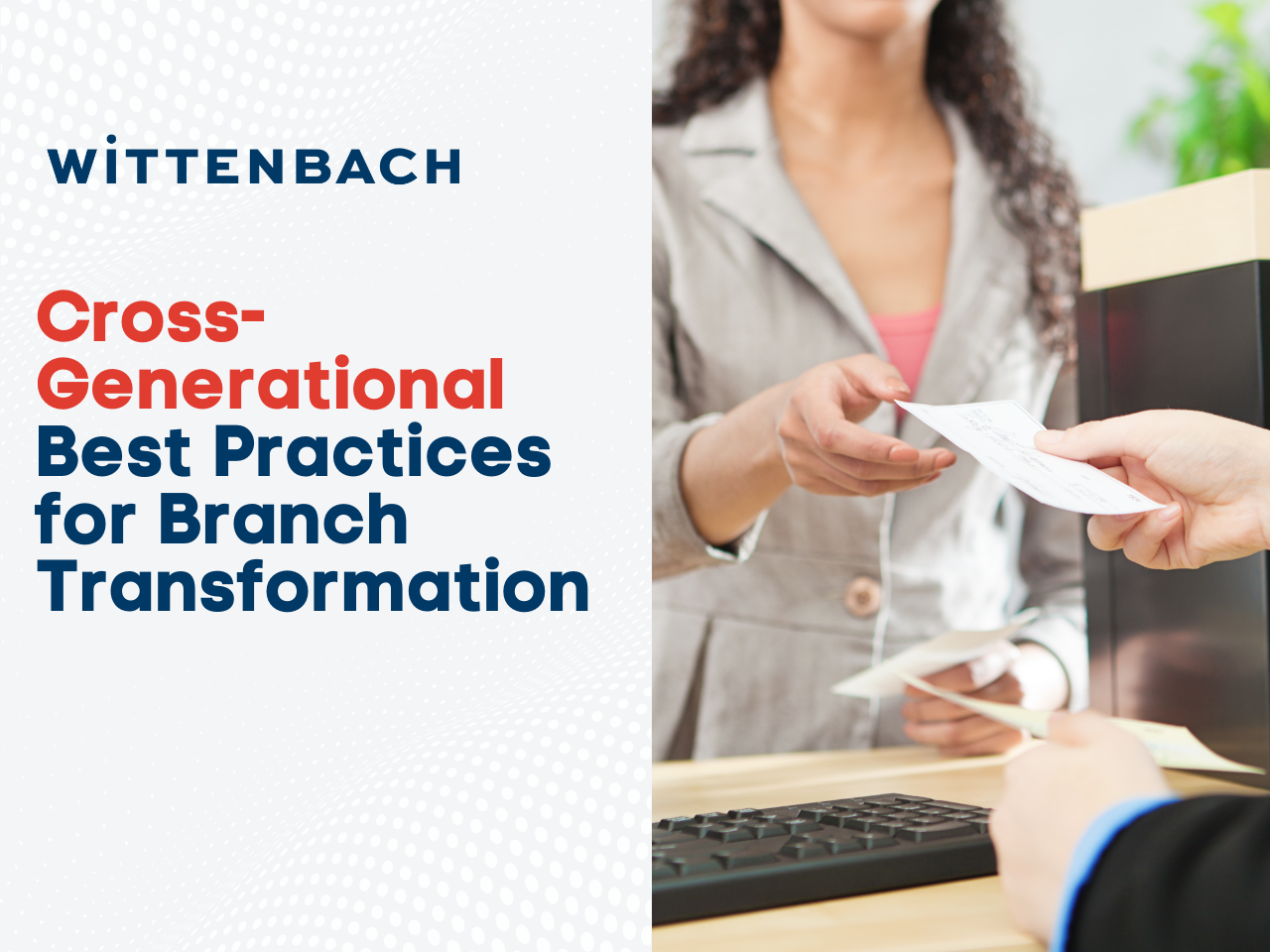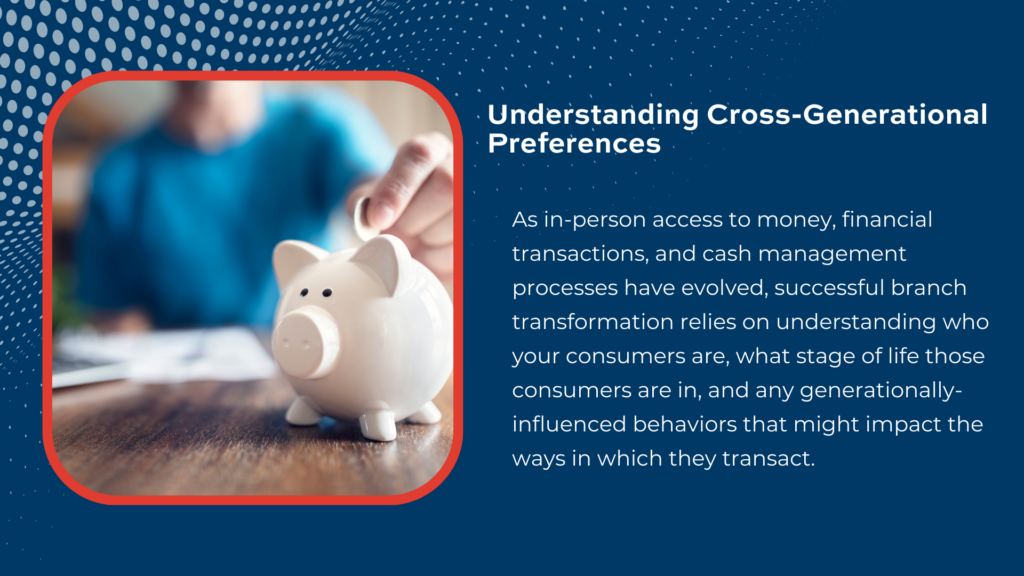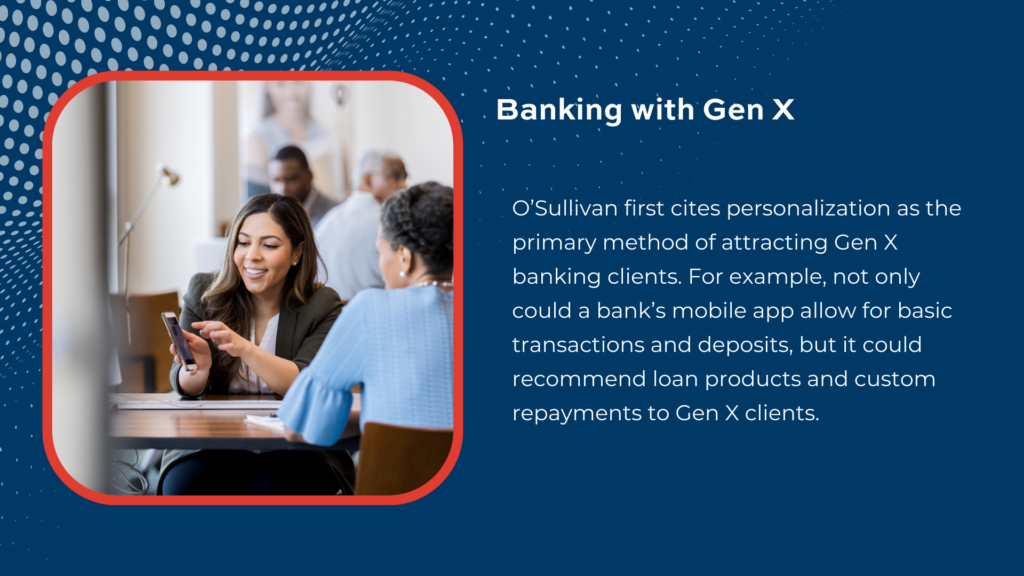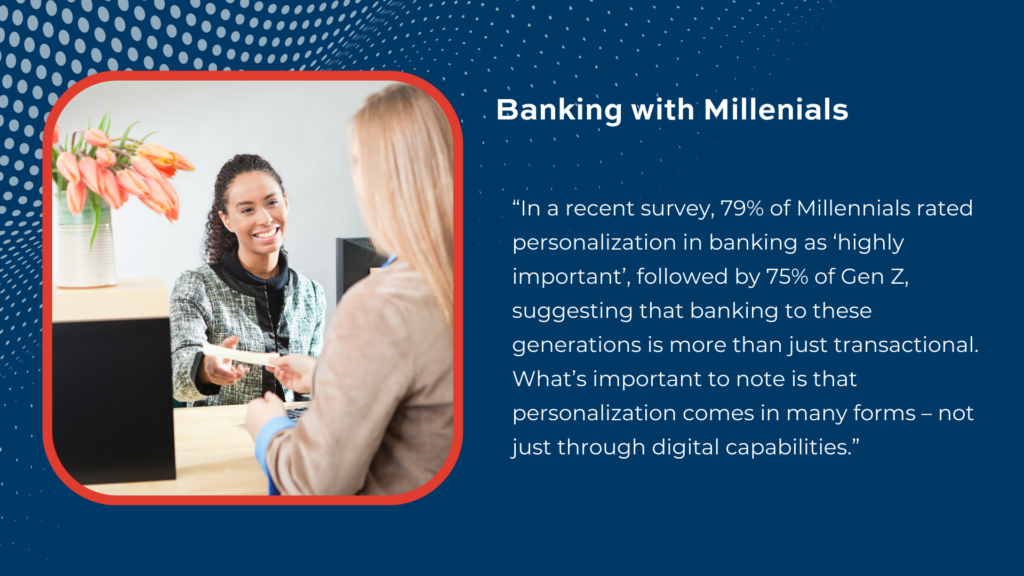As in-person access to money, financial transactions, and cash management processes have evolved, successful branch transformation relies on understanding who your consumers are, what stage of life those consumers are in, and any generationally-influenced behaviors that might impact the ways in which they transact. Brick-and-mortar bank and credit union locations remain relevant largely due to the personal touch, both inside their four walls and in drive-thru lanes. However, understanding the needs and tendencies by generation can provide insights and technology that best supports the clients of your financial institution.
At Wittenbach, we believe in meeting clients where they are, understanding the communities in which they thrive, adopting the technology that keeps branches safe, and developing best practices for branch transformation. Below, we provide guidance for transforming your branch facility or retail establishment with approaches to technology, tools, and customer service that will appeal to a wide cross-section of age groups.
Banking with Older Adults
The age range of clients 50 and older is the most cash-heavy, relying more on tangible currency and support from live staff than on credit cards, apps, or electronic platforms. Clients in the older population may also require some accessibility functionality when transacting with your financial institution, such as vision or hearing accommodations due to aging. This generation is also the largest population of in-person branch patrons, so training your staff in the art of patience will be beneficial, as they may need to bridge knowledge gaps on bank or credit union technology in a way that older clients can easily relate to.
As you undergo branch transformation, factoring in the values and preferences of aging adults will balance the scales of efficient, safe, technologically sound branch operations and ease of use for the clients who frequent your branch most often. Lastly, in post-pandemic times, considering the health concerns of immunocompromised older adults and their caregivers will help to provide a personalized experience even in a socially distanced setting. For example, in a drive-thru lane, having an ITM (Interactive Teller Machine) such as a model from the Hyosung 8300 Series will allow them to transact with a nearly touchless experience, but if questions arise, a trained video teller can join the transaction to ensure success.
Banking with Gen X
Generation X adults, born between 1965 and 1980, rely both on cash and card or electronic payments, straddling the gap of generations that lean in one direction or the other. Many of these clients are in the throes of wealth transfer from the older generations, their “Baby Boomer” parents and beyond. They may be grappling with both care expenses and inheritance from the loss of aging parents, leaving them in need of financial guidance. Ian O’Sullivan, a MasterCard Vice President, penned a LinkedIn article about Gen X’s path to financial wellness, tying in values that can be applied in a bank or credit union setting. O’Sullivan first cites personalization as the primary method of attracting Gen X banking clients. For example, not only could a bank’s mobile app allow for basic transactions and deposits, but it could recommend loan products and custom repayments to Gen X clients, also directing them to a local branch representative who can help answer questions and provide further guidance. O’Sullivan also recommended the addition of digital vaults to physical ones, offering a layer of safekeeping for wills, medical records, and other data which requires privacy and sensitivity.
Banking with Millennials
Millennials roughly include those born between 1981 and 1996. Personalization is another key to the millennial experience, in addition to speed and convenience. One Forbes article explained, “In a recent survey, 79% of Millennials rated personalization in banking as ‘highly important’, followed by 75% of Gen Z, suggesting that banking to these generations is more than just transactional. What’s important to note is that personalization comes in many forms – not just through digital capabilities.”
Many millennials are entering a time of family changes: waiting longer to get married and have children, some may be getting divorced, and many are changing careers or moving out of major cities as a result of the post-pandemic era. Not only are all of these sensitive situations, but they are nuanced and often complicated, involving the opening and closure of financial accounts, a shift in personal finances, and the need to have someone–a live person, not a screen–to truly rely on throughout the duration of these experiences.
While not as focused on cash as their parents and older banking customers, a Deloitte study indicated that millennials are explicitly stating that they need help navigating complex loans and financial life changes. Deloitte shared statistics, saying, “Sixty percent reported little or partial confidence in planning for and achieving their goals. Thirty-five percent explicitly said they need help.” Having a branch willing to discuss personal goals, as well as provide incentives, will maintain a healthy relationship with millennial clients.
Technologically savvy and valuing speed, a millennial may also use the video teller capability in your drive-through ITMs like the Hyosung 8300 series. Useful in a hurry or in off-hours, a drive-up millennial customer will have a better success rate when they can also speak to a human being if they have questions.
Banking with Gen Z
Gen Z is the youngest adult generation, capturing those born between approximately 1997 and 2012. Not only are they technologically advanced, many in Gen Z are turning to creative pursuits for income instead of traditional workplaces. A 2022 article from CNBC analyzed data from a Microsoft survey, which found that almost two-thirds of Gen Z plan to start a business, or they already have. In many cases, the pandemic years of 2020 and 2021 inspired creativity and reshaped the traditional workforce and workday, offering more flexibility in hours, locations, and approaches to productivity.
In addition, Microsoft’s data shows 91% of Gen Z entrepreneurs work unconventional hours; 81% say they work on vacation, compared to 62% of business owners overall. What comes of this is a need for business loans, advice on savings as a young entrepreneur, and beginning thoughts about long-term retirement planning outside of a corporate setting. If your financial institution is prepared to provide this guidance, you can more deeply service the needs of younger clients.
In summary
The pool of data behind generational banking trends is ever-growing and useful when deciding how to shape the future landscape of your institution and begin branch transformation. This advice is not to be used for generalizations about every client in each demographic, but rather, making informed decisions about ways to educate and empower your clients to ensure their satisfaction, and ultimately their return to your branch. Contact Wittenbach today to learn more about all the ways that we can partner on your branch transformation design, implementation, and overall support.






